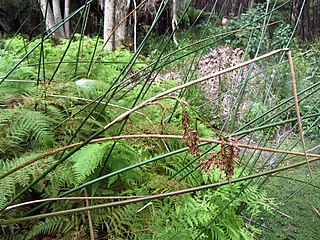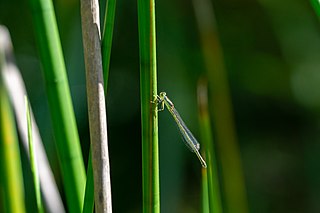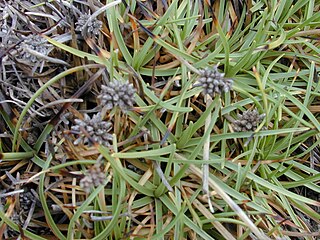Banksia porrecta is a species of prostrate shrub that is endemic to the south-west of Western Australia. It has hairy, underground stems, pinnatipartite leaves with up to forty narrow triangular lobes on each side, yellow flowers in heads of between twenty and thirty, and one or two egg-shaped follicles in each head.

Cyperus polystachyos, also known as Pycreus polystachyos and commonly known as bunchy sedge, many-spiked sedge, or Texas sedge, is a herbaceous species in the family Cyperaceae, widespread in tropical and subtropical areas around the world, sometimes extending its range into temperate regions. In the United States, it has been reported from a region from Texas to Maine.

Caustis is a genus of rhizomatous sedges. The species, all endemic to Australia, are as follows:

Baumea articulata, commonly known as jointed rush, is a sedge in the sedge family, Cyperaceae, that is native to Western Australia. The grass-like plant is rhizomatous and perennial, it typically grows to a height of 1 to 2.6 metres. It blooms between September and December producing red-brown flowers on pendulous inflorescences.
Carex fascicularis, commonly known as tassel sedge, is a species of sedge of the family Cyperaceae that is native to Western Australia and Victoria.
Caustis deserti, commonly known as desert twig-rush, is a sedge that is native to a small area in the Goldfields-Esperance region of Western Australia to the east of Kalgoorlie.

Caustis dioica is a sedge that is native to Western Australia.
Chorizandra multiarticulata is a sedge of the family Cyperaceae that is native to Australia.
Cyathochaeta avenacea is a sedge of the family Cyperaceae that is native to Australia.

Caustis recurvata, commonly known as curly sedge or pubic hair sedge, is a sedge of the family Cyperaceae that is native to Australia.
Cyathochaeta clandestina is a sedge of the family Cyperaceae that is native to Australia.

Cyperus alterniflorus, commonly known as umbrella flat-sedge, is a sedge of the family Cyperaceae that is native to Australia.
Cyperus carinatus is a sedge of the family Cyperaceae that is native to Australia.
Cyperus hamulosus is a sedge of the family Cyperaceae.

Cyperus vaginatus, commonly known as stiff-leaf sedge or stiff flat-sedge, is a sedge of the family Cyperaceae that is native to Australia.
Eleocharis pallens, commonly known as pale spikerush, is a sedge of the family Cyperaceae that is native to Australia.

Eleocharis sphacelata, commonly known as tall spikerush, is a sedge of the family Cyperaceae that is native to Australia and New Zealand.
Eleocharis spiralis is a sedge of the family Cyperaceae that is native to Australia.

Fimbristylis cinnamometorum is a sedge of the family Cyperaceae that is native to Australia.

Fimbristylis cymosa, commonly known as tropical fimbry, or St. John's sedge, is a sedge of the family Cyperaceae that is native to Australia.










